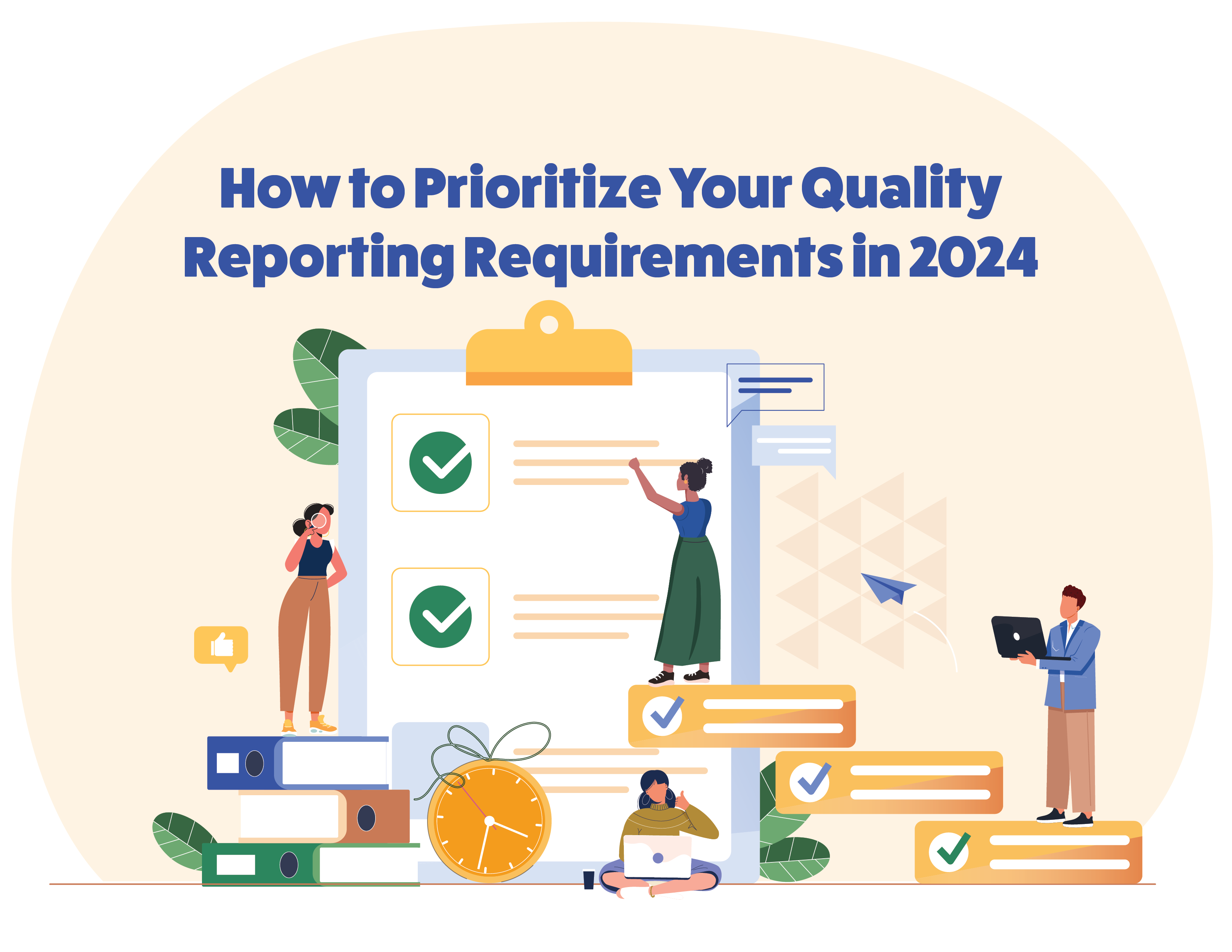How to Prioritize Your Quality Reporting Requirements in 2024
By Karen McLaughlin March 1, 2024 Regulatory Updates: Hospital

Feeling overwhelmed with the new requirements, measures, and reporting periods? I can’t imagine you're feeling as though you’ve got more time in your day now as compared to two years ago. But this year, your regulatory requirements (from a submission standpoint) have essentially doubled.
So where do you begin? How do you prioritize what needs to be done this year and what can wait?
Let's start by reviewing the new requirements for 2024 that you'll need to work on this year.
- IQR (Inpatient Quality Reporting): 2024 Full IQR Reporting Requirements
- eCQMs: eCQM reporting went from four measures for four quarters last year to six measures for four quarters this year and there are two new required measures (PC-02 & PC-07)
- Health Equity measures: two new required measures (SDOH-1 & SDOH-2)
- Hybrid measures: two required measures (HWR & HWM). Technically this is a 2023 requirement, but your first submission is due by October 1, 2024.
- PRO-PMs: CMS has introduced the IQR program’s first Patient-Reported Outcome-Based Performance Measure (PRO-PM). Technically this is a 2025 requirement, but data collection for mandatory reporting begins on April 2, 2024.
- eCQMs: eCQM reporting went from four measures for four quarters last year to six measures for four quarters this year and there are two new required measures (PC-02 & PC-07)
- PI (Promoting Interoperability): 2024 Full PI Reporting Requirements
- The reporting period went from 90 consecutive days last year to 180 consecutive days this year.
- You are required to submit a new measure called the Antimicrobial Use and Resistance Surveillance Measure.
- ORYX® (The Joint Commission (TJC)): 2024 Full ORYX® Reporting Requirements
-
PC measures are required for everyone with OB services. Furthermore, TJC is removing the requirement to submit PC-01, PC-02, and PC-05 as abstracted measures. Instead, hospitals must submit PC-02 and PC-07 as eCQMs. However, they have retained the requirement for hospitals to submit PC-06 as a chart-abstracted measure, but you can submit it as an eCQM and still meet that requirement.
-
- OQR (Outpatient Quality Reporting):
- eCQMs: for the first time, CMS is requiring the submission of one eCQM (STEMI) in the OQR program.
These new requirements are in addition to everything else you've been submitting across these programs. That's quite a list to keep track of! It's going to be crucial for you to establish a clear starting point, determine your priorities, and effectively manage the workload. To help you with this, we’ve created a list of priorities 1–6, along with goals for deadlines to complete this work.
Priority One: Address Your Required IQR eCQMs
Goal: Completed by July 1, 2024.
At the start of this year, you should have already started tracking the three required eCQMs: Safe Use of Opioids - Concurrent Prescribing, Cesarean Birth, and Severe Obstetric Complications. These measures must be reported for CY 2024 and will be made public. It is crucial to have accurate data. If you aren’t 100% sure your measures are an accurate reflection of the quality of care at your organization, you’ve got some validation work to do as early in the year as possible.
Your PC measures are especially important to get right this year. They are reported to the IQR program which takes care of your PI requirements too. They are also reported to the ORYX® program, and if you can get the PC-06 measure tracked as an eCQM you can eliminate the abstracted measure submission component of the ORYX® program.
Also read:
Once the required measures are validated, you can move on to three self-selected measures. It is likely that you already have these three self-selected measures validated and performing well. Which is great! Set aside some time early this year to look at the new eCQMs that have been released recently. There is a high chance CMS will retire any measures they feel are topped out and ask you to start tracking new measures (I’m looking at you, STK and VTE). Look at the new measures coming out and make a plan for if, what, and when you want to add these measures to your system to begin tracking and validating for accuracy.
New measures added to IQR program:
- IP-ExRad eCQM
- Note: the Excessive Radiation Dose or Inadequate Image Quality for Diagnostic Computed Tomography (CT) in Adults (Hospital Level — Inpatient) - otherwise known as "ExRad "eCQM is not required in the IQR program, however it is required in the OQR program in Calendar Year 2027. You should consider implementing this measure on the inpatient side now so you’re prepared for the outpatient version and can participate in the voluntary reporting periods before it’s required. This measure is a doozy.
Also read: How to Implement the Inpatient ExRad eCQM
- Note: the Excessive Radiation Dose or Inadequate Image Quality for Diagnostic Computed Tomography (CT) in Adults (Hospital Level — Inpatient) - otherwise known as "ExRad "eCQM is not required in the IQR program, however it is required in the OQR program in Calendar Year 2027. You should consider implementing this measure on the inpatient side now so you’re prepared for the outpatient version and can participate in the voluntary reporting periods before it’s required. This measure is a doozy.
- Hospital Harm Measures: CMS has released a suite of Hospital Harm measures. These measures are similar to your old PSI claims measures. You should expect to see these proliferate and maybe even become required in the next few years.
- Opioid-Related Adverse Events (ORAE)
- Pressure Injury (HH-PI)
- Kidney Injury (HH-AKI)
- Hypoglycemia (HH-Hypo)
- Hyperglycemia (HH-Hyper)
- Global Malnutrition Composite Score (GMCS)
Priority Two: Set up your Health Equity Screening Process
Goal: Have a screening process in place by April 1. Develop/improve/enhance your community-based organization (CBO) relationships by the end of the year.
In 2024, CMS introduced a new initiative to address health equity in a meaningful way. CMS is requiring hospitals to report the measures SDOH-1 and SDOH-2. These measures require you to screen every single patient who is admitted to your hospital ages 18 and older for five health-related social needs.
As you can imagine, setting up this system will require involvement with multiple stakeholders. You’ll need to meet with your nursing staff, case management, IT, and/or social workers to determine the best workflow for collecting this data and referring individuals to appropriate resources. Medisolv has configured these measures as eCQMs so you can more easily track and validate performance on these measures.
Also See:
- An Intro to CMS’s SDOH Measures
- How to Build Your SDOH Screening Process
- Quality Advice: Tips for Your Hospital SDOH Screening Process
- [Client Interview] How to Take Control of Your SDOH Data
P.S. Medisolv is presenting with LifePoint Health at HIMSS about how LifePoint rolled out the screening process to all their hospitals using the Medisolv Equitable Care Module. Come visit us at booth #1741.
Priority Three: Figure out how you’ll handle the new PRO-PM
Goal: Start uploading your patient surveys by the start of Q3 (October 1, 2024).
CMS rolled out a brand-new measure type to the IQR program – the Patient Reported Outcomes-Based Performance Measure or PRO-PM. The first required PRO-PM is the Inpatient THA/TKA measure. It requires you to give a survey to every elective total hip and total knee patient before surgery and then again after surgery. CMS will calculate your (risk-adjusted) rate of clinical improvement as reported by the patient. CMS has already finalized their decision to add the outpatient version of this measure to the OQR program next. So it’s imperative you get this figured out quickly this year.
We have had a ton of questions on this measure. We suggest you start by reading the measure logic carefully. Once you understand the measure algorithm, then make sure you understand where your inpatient elective surgeries are sourced from. If you have practices using your facilities, you’ll need to understand where they are capturing responses to these surveys (hopefully they are already asking these survey questions, but if not they need to be). Then you must get it into a format that can be aggregated so you can begin the process of abstracting the data for each case.
Medisolv has developed a PRO-PM module to help hospitals track and submit these measures to CMS.
Also see: A Quick Guide to the THA/TKA PRO-PM Measure
Priority Four: Validate your Hybrid Measures
Goal: Completed by July 1, 2024.
There are two required hybrid measures in the IQR program in 2024. We have been submitting these hybrid measures on behalf of clients for five years now, and even we were confused when CMS sent back hybrid measure HSRs (Hospital Specific Reports). We learned valuable lessons from these measures during the voluntary reporting period. You should be engaged in validating these measures, so you don’t fail to meet the minimum requirements and risk taking a penalty in the IQR program.
There are six linking variables that must be present for each patient. Additionally, for patients aged 65 and older with Medicare, all necessary vital signs and labs must be completed within the designated timeframe.
Also see: 4 Lessons Learned from Hybrid Measure Submissions
Priority Five: Ensure your PI Objectives are met in the new timeframe.
Goal: Ready by July 5, 2024.
This year, you are required to report for 180 days instead of 90 days. This means your reporting period cannot start any later than July 5, 2024. Use the second quarter of 2024 to ensure all interfaces are functioning correctly and you have the necessary data for all required objective measures.
Also see: 2024 Promoting Interoperability Requirements
Priority Six: Track and validate the STEMI eCQM
Goal: Validate the measure is accurate no later than September 30, 2024.
For the first time this year, one eCQM must be reported for the OQR program. This eCQM is Appropriate Treatment for STEMI patients in the ED. The key to this measure is timing, so prioritize your time by addressing workflows that will yield the necessary results. Once these workflows are in place, monitor your data to ensure they remain effective.
Also see: STEMI: The First eCQM for the OQR Program
In conclusion, navigating the ever-changing landscape of quality reporting requirements can be overwhelming. However, by prioritizing your tasks and setting clear goals, you can effectively manage your workload and ensure compliance with the necessary measures. Start by addressing your required IQR eCQMs and validating their accuracy. Then, focus on setting up your health equity screening process and handling the new PRO-PM measure. Don't forget to validate your hybrid measures, meet the new Promoting Interoperability requirements, and track and validate the STEMI eCQM. By following these priorities and goals, you can successfully navigate the quality reporting requirements of 2024 and provide the best possible care to your patients.
Medisolv Can HelpThis is a big year for Quality. Medisolv can help you along the way. Along with award-winning software, you receive a Clinical Quality Advisor that helps you with all of your technical and clinical needs. We consistently hear from our clients that the biggest differentiator between Medisolv and other vendors is the level of one-on-one support. Especially if you use an EHR vendor right now, you’ll notice a huge difference.
|






Add a comment